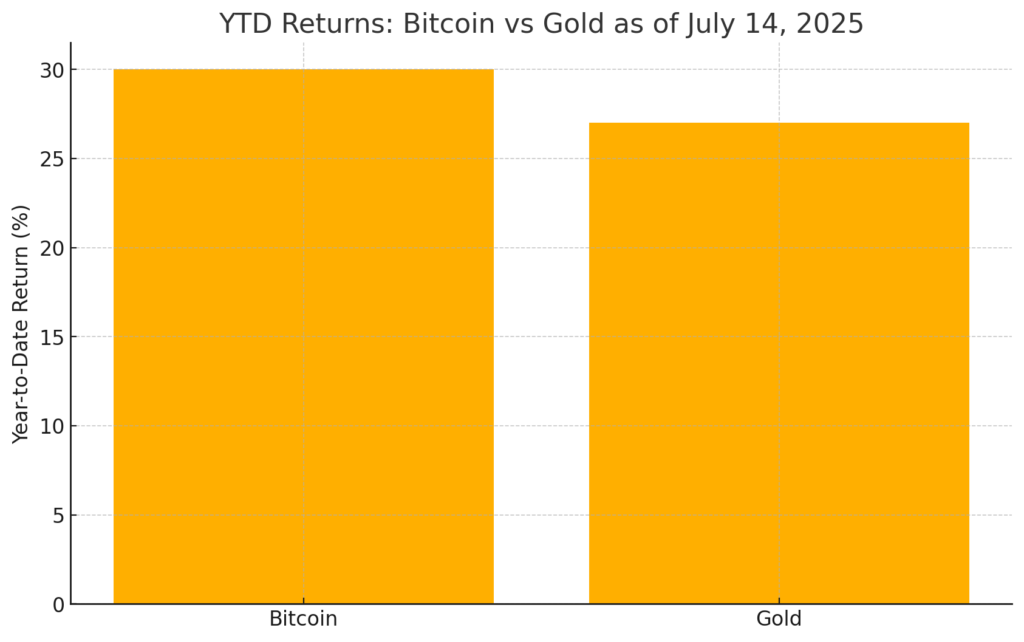
Main Points:
- Bitcoin has surged about 30% year‑to‑date, eclipsing gold’s roughly 27% gain, and set fresh all‑time highs above $122,000.
- Record inflows of $3.7 billion into digital asset funds last week pushed total AuM past $211 billion.
- The U.S. Dollar Index has plunged nearly 11% in the first half of 2025, weakening the dollar and fueling safe‑haven flows into gold and Bitcoin.
- U.S. spot Bitcoin ETFs amassed over $50 billion in net inflows since launch, with BlackRock’s IBIT leading at about $86 billion AuM.
- The “Big Beautiful Bill” boosted government borrowing capacity, underpinning inflation concerns and driving further demand for non‑productive assets like Bitcoin.
Market Performance: Bitcoin vs. Gold
Bitcoin (BTC) and gold have both earned top honors in 2025, emerging as the year’s best‑performing major assets. As reported by James Van Straten, Bitcoin has climbed approximately 30% from January to mid‑July, breaking above $122,000—a fresh all‑time high—while gold has rallied around 27%. Figure 1 illustrates these year‑to‑date returns side by side, underscoring Bitcoin’s edge in the current macro environment.

Historically, gold has been the go‑to safe haven during periods of economic anxiety. This year, however, Bitcoin’s blend of digital scarcity and growing institutional adoption has propelled it to the forefront. In mid‑July, BTC’s weekly close of $119,500 cleared the previous record and set the stage for an encore break above $122,000, cementing its leadership over gold in percentage gains (Van Straten, July 14, 2025).
Macro Drivers Behind the Influx into Non‑Productive Assets
Several interrelated factors have ignited investor interest in “non‑productive” assets—those that do not generate cash flows such as dividends or interest.
- Dollar Weakness: The ICE U.S. Dollar Index (DXY) has plunged nearly 11% in the first half of 2025, the steepest six‑month drop since 1973. A weaker dollar diminishes the purchasing power of cash holdings and heightens the appeal of hard assets like gold and Bitcoin for preserving value.
- U.S. Fiscal Deficit: In May, the U.S. government recorded a historic monthly deficit of $316 billion, exacerbating concerns over future inflation and currency debasement (Van Straten, July 14, 2025).
- Geopolitical Tensions & Trade Policy: Delays in new tariffs, fluctuating U.S.‑China negotiations, and military actions in the Middle East have heightened uncertainty, driving safe‑haven flows.
These conditions collectively distort capital costs and hamper productive investments, encouraging a tilt toward assets perceived as stores of value rather than sources of yield.
Institutional Adoption Accelerates
Institutional inflows into crypto have surged to record levels. According to CoinShares, digital asset funds enjoyed $3.7 billion of net inflows for the week ending July 11—the second largest ever—pushing total AuM past $211 billion for the first time. Bitcoin products alone accounted for $2.7 billion, matching 54% of the total AuM in gold exchange‑traded products.
U.S. spot Bitcoin ETFs, which debuted in early 2024, have been a major conduit for this institutional demand. Collectively, they have amassed over $50 billion in net inflows, with BlackRock’s IBIT fund topping $86 billion in assets, making it the fastest ETF in history to reach that level. On July 11 alone, spot ETFs pulled in over $1 billion in daily inflows as Bitcoin pierced new highs.
This institutional embrace not only deepens liquidity but also cements Bitcoin’s evolving role as a recognized — if nascent — component of diversified portfolios.
Regulatory Tailwinds from the “Big Beautiful Bill”
Since Congress passed the “One Big Beautiful Bill Act” on July 3, Bitcoin has benefited from renewed macro tailwinds. While the legislation contained no direct crypto provisions, it dramatically expanded the U.S. government’s borrowing capacity, stoking inflation expectations and weakening the dollar.
Simultaneously, Washington has designated mid‑July as “Crypto Week,” with lawmakers debating three key bills—the Genius Stablecoin Act, CLARITY Act, and the Anti‑CBDC Surveillance State Act—which aim to clarify digital asset tax treatment, establish stablecoin standards, and limit central bank digital currencies. This flurry of legislative attention has bolstered investor confidence, underlining an official shift toward integrating crypto within traditional finance frameworks.
Practical Blockchain Applications in a Volatile Environment
For those seeking new crypto assets and revenue streams, the current climate offers fertile ground:
- DeFi Yield Strategies: With higher interest rates in traditional markets, DeFi protocols offering double‑digit yields on stablecoin collateral have attracted fresh capital. Platforms like Aave and Compound remain popular for liquidity mining and lending, despite counterparty and smart‑contract risks.
- On‑chain Risk Management: Enterprises are experimenting with blockchain for real‑time supply‑chain tracking and automated compliance. Tokenizing trade finance assets can streamline documentary processes and reduce settlement times.
- Stablecoin Adoption: As dollar volatility persists, algorithmic and fiat‑backed stablecoins are finding niche use cases in cross‑border payroll and treasury management, especially in regions with underdeveloped local banking infrastructure.
- NFTs & Tokenized Real‑World Assets: Beyond art, blockchain is enabling fractional ownership of real estate, art, and revenue streams—opening alternative investment avenues for retail and accredited investors.
These practical applications underscore the maturing utility of blockchain beyond pure speculation, aligning with investors’ search for actionable use cases.
Conclusion
Mid‑2025 has witnessed an extraordinary convergence of macro, fiscal, and regulatory forces that have propelled Bitcoin past $122,000, outpacing gold’s 27% return with a roughly 30% gain (Van Straten, July 14, 2025). Record inflows into digital asset funds, a vulnerable U.S. dollar, and sizable fiscal deficits have underscored investor anxiety and driven demand for non‑productive assets. Meanwhile, the rapid rise of U.S. spot Bitcoin ETFs—with BlackRock’s IBIT leading—signals institutional validation and deepening market infrastructure. As the U.S. debates crypto‑friendly legislation during “Crypto Week,” the stage is set for further growth in digital assets and their pragmatic deployment across finance and industry. For readers scouting new crypto opportunities or exploring blockchain’s practical applications, this environment offers both headwinds and unprecedented openings for innovation and yield.

